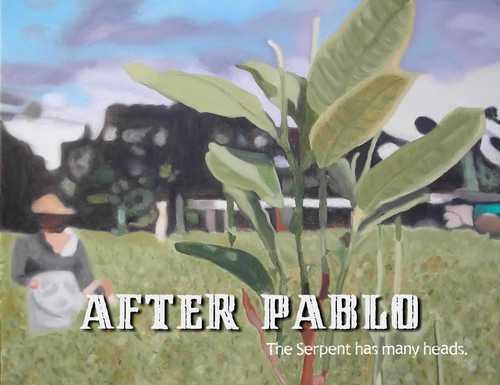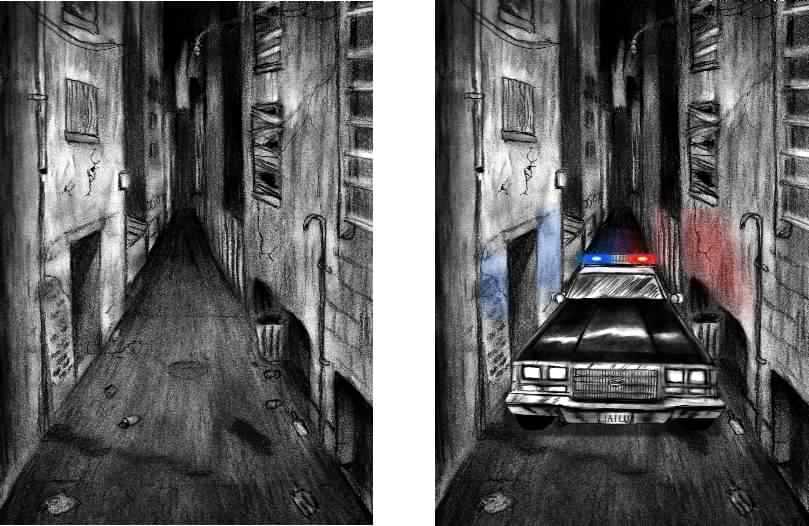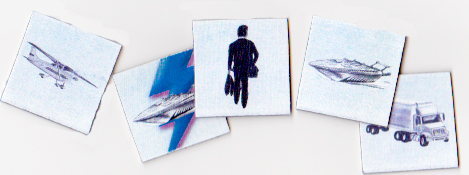
Please note: Nathan Hayden, the designer and lone man at Blast City Games (makers of San Quentin Kings) was kind enough to send me a copy for this review.
It’s well known in my gaming circle that I’m not a fan of economic games. Partially ‘cause I suck at them but mainly ‘cause the theme tends to be uninteresting to me. I’m not into kowtowing to some renaissance bigwig, shipping “colonists” to plantations nor do I want to be some blow-hard railroad baron. In After Pablo though. I’m the head of a drug Cartel and I gotta make me some fat stacks all the while having complete domination over my competition. Ohhhhhh, Papa likes!
Here’s the premise; Pablo Escobar the infamous Columbian drug lord (once listed in Forbes magazine as the seventh most wealthiest person), has been tracked down and killed by Columbia’s Special Forces. As the head of your own Cartel, you want to take over his lucrative narcotics empire, but so do your opponents. “After Pablo” by Blast City Games, pits players against one another in attempt to control Escobar’s legacy by buying, smuggling and selling cocaine to the US as well as paying for favours to the DEA, hiring a cadre of Lawyers and Assassins and of course starting wars against rival Cartels. The game ends after 12 rounds (or seasons) and the player with the most Command Points (CPs) wins.
OVERVIEW
Before getting into the meat of the game I thought that I’d take a little time to talk about one of your main assets. The Cartel Card.

Cartel cards will be used throughout the game in a few ways. Players will either buy or bid for them, play them from your hand for the listed ability or icon as well use them to perform “checks” with.
For instance, if during a "Crossing the Border" action, a player cannot match all five of the vehicles on the board, he would have to make a “check” by drawing the top card from the cartel card draw pile and flipping it over. If there’s an empty alley he has passed but if there’s a cop car, the player is busted and must lose a cube of cocaine back to the off board supply and one influence (from his pile or from on the board) to the jail track.

This draw mechanic is used again during the “selling” phased but players will perform a check by flipping the Cartelthat are on the board It’s simple but it adds another layer of strategy as other players may try to make the on board cards less conducive to the selling player by buying any possible “safe” cards and replacing them with other cards from the draw pile. . This also changes the dynamic of the board in way that influence the next person to buy cartel cards or trying to sell. Most every action changes the board and forces player’s to rethink their next move.
On your turn, you'll move your Associate Pawn to different areas on the board as you choose one of five actions:
1) Taking a Business action will allow a player to either pay for influence on the boards or buy Cartel cards (you must choose to do one or the other, not both).
2) Buying cocaine. Players can buy it for $1 per cube of coke (max. of 5 allowed). If a player has the most influence on the Columbian flag, the money goes to him. If no leader is present the cash goes to the bank.
3) Start a War. A player will move his Associate pawn to either Columbia or Mexico and try to reduce or eliminate the influence another player has on that country’s flag. Combat is very straight forward the attacker will play any number of “guns” they have on their cartel cards and or “asesinos” (assassins) in that country (which would have been bought during a previous Business action). Once the attackertotals his combat value the defender does the same. The winner is the player with the higher total. The loser must remove a number of influence according to the difference in totals. If the attacker wins the player adds 1 influence in that country. The defender gains nothing if she wins.
4) Crossing the Border. The player attempt to smuggle all his coke cubes across the border using various modes of transportation. A track on the board has five face-up tiles with different transport symbols on them, (e.g. A plane, two speedboats, a dude and an SUV.) The player must try to match those symbols with the cartel cards he has in his hand.

5) Selling to the USA. This can only be taken if you used the Crossing action on the previous turn. Similar to that you will look at the face-up cartel cards on the board. Each will have a price on the board above every card from $8 to $10. You must sell each cube of coke to one face-up card. You are guaranteed a safe deal if the Cartel card you’re selling to matches your cartel’s colour. For every card that doesn’t you must make a check.
Every time a player gets a cube “arrested” itis placed on the Jail track. By either playing special abilities from Cartel cards (like the Lawyer/ politician card) or due to in-game mechanics your cubes will /can be moved down thetrack. When the influence cubes move out of the last space (or the "Acquittal" box) they are returned to your influence pool. At the end of the game if any of your cubes are anywhere on the “Jail” track you will lose 1 CP per cube.
There’s also DEA track that, when triggered, causes the leaders in both Mexico and/ or Columbia to lose an influence cube from their respective countries. This happens after Crossing action has been completed. The bottom two Crossing tilesare discarded, the remaining tiles are shifted and two new tiles are added at the top. For every lightening bolt present on a tile, the DEA marker is moved one space. Once the marker reaches the end of the track arrests are made.
Luck is a part of this game whether it's through drawing cards to be placed on the board or making checks with but there are thematic luck mitigators thatplayers can use. If you need to get a little insurance before crossing the border you can buy influence within the DEA which allow you to redraw a card during checks.
There is direct player interaction by using the War action or by revealing a Snitch in a rival Cartel’s midst.

Playing a Snitch card on an opponent, makes him deal with a negative effect (known as B.S), like losing cash or influence for example. Once the BS has been resolved your opponent then has to deal with the Snitch. They would have to kill him by either using 2 guns, from off of the board or in your hand or removing an influence from your DEA folder or Country flag. Your opponent could also do nothing and receive a “Weakness” chip, which will add anegative number to your final score depending on how many Weakness chips one has ( 1 chip=-1 CPs, 3 chips= -6 CPs).
MY THOUGHTS
I really really dig this game and I think it’s a solid title. After Pablo takes familiar mechanics like area control, bidding and set collection and uses them in a way that’s highly thematic and in many ways creates a sense of narrative. Every action and decision a player takes, makes sense within the context of this highly dynamic underworld. You’ll have to rely on short-term planning as things change on the fly but nothing is more satisfying than making a border crossing and sales with all your coke and turning around to start a War to make yourself the leader of a country. The multi-purpose cartel cards are an excellent choice that pulls all the game elements together in a simple yet effective way.
There's plenty of quality player interaction and players will be involved in nearly every turn as the board changes.
On the whole the components are good, with the exception of the Crossing Border tiles, which are downright crappy. It seems as though the images were printed out from a home computer and glued with a glue stick onto thin chip board. The blank side seems to have been painted with poster paint. One tile has already begun to peel away from it's backing and the edges on the painted side are beginning to chip. The Cartel and cash card quality on the other hand is pretty good.
The playing boards (there are three of them) are made with a chipboard backing and reminded me a lot of GW’s Talisman Timescape board (for those old and/or fortunate to remember). It's not mounted so it will take a little coaxing to get it to lay flat on the table. One can't screw up wooden cubes and they are a great fit for this game as they represent your dudes and of course blocks of cocaine. No Dorothy were not in Euroland anymore.
One of the most contentious points for some, will be the art style. It’s rough, crude and Naïve but it works for me. Why? 'Cause it feels thematic. I couldn’t imagine the slick graphics similar to that of Cuba or Small World working for a game like this. In my opinion the art reflects the aggressive and brutal nature of the drug trade, it's edgy, off kilter and a n big improvement over Blast City's other game San Quentin Kings. I will say the box cover art wholly misrepresents the game with it's pastel, impressionist-like art but other than that I think the artwork for the rest of the game is awesome.
Of course no game is perfect and After Pablo is no exception. In attempt to soothe game statisticians (Jeb, I’m lookin’ at you), all cards are listed withan arrestprobability for when making checks. For instance if a card lists 2/3 it means two cards in this set of cards are arrest cards.( A printing error on the Snitch card says 0/1 but it should be 1/1 as all snitch cards will cause an arrest.)In my group,I think a player did use it once during a “Selling” check but overall it was largely ignored. Also at the end of each round, players can buy one "Luxury" item like Women / Beauty (?) or an Estate. What it is really is a straight up CP grab. You receive no item and it feels anti-thematic in a way. I was hoping that the items would give you some semi or permanent effect, like requiring an opponent to spend an 1 extra gun in a War action against you if you have an Estate /Compound or something to that effect.
Another minor niggle was the choice to have the money denominations in tens versus thousands. Having to hire an Assassin for $10 seems a bit silly. It could have simply been solved by having all denominations end with a K.
So do I recommend this? Hell yeah! It looks like it's currently sold out but if it goes into a second printing I would highly suggest the designer fix the Crossing tiles as that stands out as the weakest element in an otherwise fantastically fun and deep game.
MY NON-GAMING RECOMMENDATIONS:
No Country for Old Men (book or film) - Cormac MacCarthy
Breaking Bad (TV) ( Season 2 specifically)
Scarface (film) Brian De Palma / Oliver Stone
Narcocorrido music (Mexican music about Drug lords and their exploits)